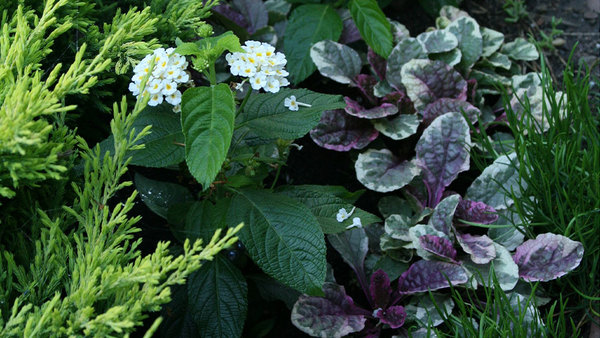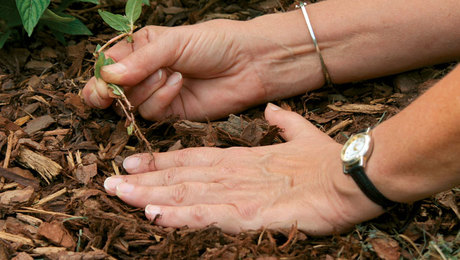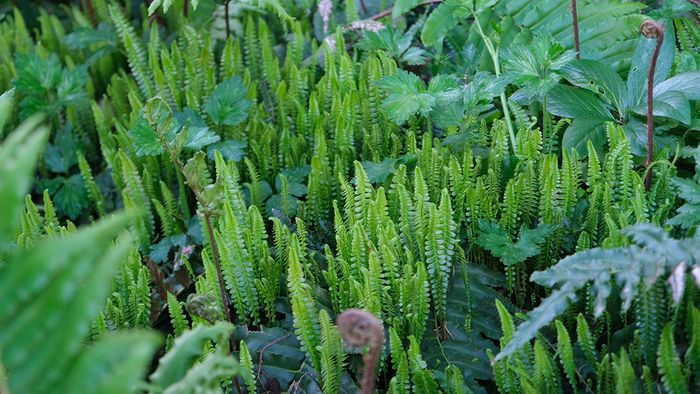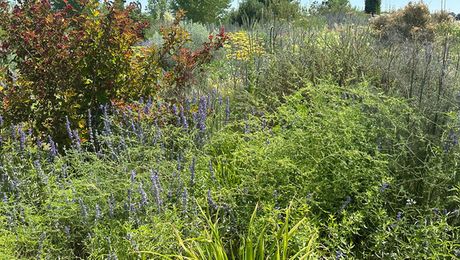
Over the years, as I’ve walked from my house to a nearby track to exercise, I’ve noticed small, gradual changes in the way my neighbors combat weeds. Slowly, they’ve shifted from herbicide applications to alternative weed control methods like mulching and planting competitive native plants. At my office, the Bio-Integral Resource Center in Berkeley, California, we encourage this new approach to weed control called IWM, or Integrated Weed Management.
IWM is modeled after Integrated Pest Management (IPM) and begins with identifying and monitoring the weed populations in your landscape. Next you determine a threshold, or the number of weeds you will allow in your garden. Once the number of weeds passes that threshold, you need to decide upon control methods, including cultural, physical, mechanical, or least-toxic chemical controls. This system can be used effectively by homeowners and especially by garden professionals to prevent and manage weed problems in a way that’s least toxic to the environment.
Design new plantings to keep weeds out
In a new garden, IWM practices should focus on weed prevention rather than control. One way to avoid introducing weeds to a newly planted area is to check containerized plants carefully when purchasing them to make sure they are weed-free. Also, when buying compost, manure, or topsoil, remember to ask if it has been properly composted to reach between 140 F and 150 F. Composting at high heat ensures that weed seeds have been killed.
When creating new plantings, you can design them so that weeds don’t have room to become established. By suiting your plants to the cultural conditions, the plants you want will flourish, and weeds will have no place to grow. Native plants are especially useful because they are generally well adapted to local conditions, and they compete well against weeds. You can also use groundcovers, trees, and shrubs to shade the ground so weeds will not grow beneath them. Underplant newly planted trees and shrubs with fastgrowing annuals like sweet alyssum (Lobularia maritima) and flaxes (Linum spp.) to crowd out weeds. In climates where plants depend on watering, use drip irrigation to deliver water only to ornamentals and not to weeds. You can even try allelopathic plants, like sunflowers, manzanita, and some sages, which secrete toxins that can suppress the growth of other plants.
More reading:
Managing Weeds with a Light Touch (Part 1)
Managing Weeds with a Light Touch (Part 2)
Keeping Up with the Garden
Besides using plants to deter weed growth, synthetic mulches are also effective tools for suppressing weeds. The best time to install plastic mulches or landscape fabrics is when you’re installing a new planting. Black plastic sheeting (polyethylene), or spunbound, woven, or nonwoven landscape fabrics (polypropylene or polyester) are available. Black plastic suppresses weeds better than fabric in some cases, but landscape fabrics last longer, allow water to drain through, and are sold in sheets of convenient sizes that may be easier to use. In fact, some fabrics are precut into “tree circles” that provide a circular weed-free area beneath trees. All these synthetic mulches are degraded by sunlight and should be covered with a 2-inch layer of organic mulch or some sand or gravel, to protect them. They can last from 5 to 10 years or sometimes even longer.
In addition to synthetic mulches, organic mulches should be part of your initial and ongoing IWM program. Coarse mulches, like large bark chips, should be used in areas of high rainfall, because they allow water to drain quickly. Deep mulches are more effective at controlling weeds than shallow ones. As a rule, organic mulches should be 2 to 4 inches deep, and they should not come in direct contact with the trunks of trees or the crowns of plants.
Create a weed map to identify problem areas

Set weed tolerance thresholds
Once your new landscape is installed, or when you inherit a landscape, the next step is to monitor for weeds and set weed tolerance thresholds. One way to do this is by making a weed map (see above). First, draw an outline of your yard, then note on the map the names of weeds you observe, where they are, and their stage of growth. Knowing the types and number of weeds present will help you determine how many weeds you can tolerate. You may consider some weeds to be aesthetically pleasing and nonaggressive growers, so you can tolerate these at certain numbers. Other weeds may be useful herbs or can be refuges for beneficial insects, since they provide them with pollen, nectar, prey, or alternate hosts. Some weeds, however, like nutsedges (Cyperus spp.) or Canada thistle (Cirsium arvense), should be removed at once or they may quickly take over your garden.
Drawing a weed map will also help you determine which areas of your garden require your energies and when they will need treatment. For instance, an area overrun with annual weeds like shepherd’s purse (Capsella bursa-pastoris) and common chickweed (Stellaria media) should be treated before they can set seeds. Perennial weeds, like ground ivy (Glechoma hederacea) hand, are weakest a few weeks after emergence, when food stored in the roots has been exhausted, so this is a good time to treat them.
Creating a weed map also gives you valuable information about soil conditions, including drainage, acidity level, and fertility. Certain weeds will flourish under certain cultural conditions, so the presence, or health, of a specific weed can indicate something about the soil. For example, the appearance of spurge (Euphorbia spp.), black medic (Medicago lupulina) or crabgrasses (Digitaria spp.) can mean the site is too dry (and probably compacted). Moneyworts (Lysimachia spp.) and nimblewill (Muhlenbergia schreberi) are indicators of chronically wet conditions. Broadleaf plantain (Plantago major) and goosegrass (Eleusine indica) indicate compacted soil. Red sorrel (Rumex acetosella) shows up in acidic soil, and sites low in nitrogen lead to clovers (Trifolium repens), bird’s-foot trefoil (Lotus corniculatus), and black medic. When signature weeds appear on your map, you can try to get rid of them by aerating or cultivating, working compost and slow-release fertilizer into the soil, or treating acidic soil with lime.
Tools to make weeding easier



Using these tools makes it much easier to fight weeds in your garden.
Choose controls that are effective and safe
When the number of weeds in your garden becomes greater than your tolerance level, you need to decide how you will treat the problem. Sometimes the best way to control a weed is to just grab it and pull it out of the ground. Hand-pulling is very effective for annual weeds, but be sure to get these before they have set seed and when the ground is moist. Use a collinear hoe to scrape the tops off annual weeds at ground level. Use a hula hoe (also called a stirrup hoe) or dandelion knife to chop weedy grasses out just below the soil surface. Use a mower or tiller to remove the above-ground growth of perennials, thus defeating photosynthesis and depleting food stored in the roots. With some persistent perennial weeds, you may need to repeat the process more than once.
Soil solarization is a good method to use in sunny gardens to rid beds and other areas of difficult perennial weeds before planting. It takes four to six weeks for solarization to kill pest nematodes and plant-disease pathogens as well as weeds. To solarize, cultivate the soil, water it, then cover the area with a thin sheet of transparent polyethylene. Hold the plastic in place by digging a trench and burying the edges in soil. In cooler areas, you can increase the effectiveness of this method by using two sheets of plastic. Solarization is, of course, not useful for killing weeds in perpetually shady areas.
For weeds in sidewalks, gardens, or lawns, handheld weed flamers—small tanks of propane with a wand that produces a flame—are available. It is best to flame broadleaf annual weeds when they are 1 to 2 inches high, but flaming can also be effective at killing grasses and perennial weeds in some circumstances. Since mature grasses are resistant to flaming because emerging blades are protected in a sheath, flaming can be a good way of removing broadleaf weeds from lawns.
In addition to flame weeders, new, portable, propane-powered, flameless radiant heaters are good at killing weeds. On this device, a hot ceramic surface kills foliage, and a red-hot spike that can be pushed into the ground kills perennial roots. Another potentially useful product heats water from a garden hose to the boiling point, and the water is then sprayed directly on weeds. The simple act of watering weeds will kill them.
Flaming and other thermal methods of weed control can kill many weeds and grasses, but several treatments may be necessary. The first application of heat may cause the plant to die back, but if the roots are not killed, it will resprout. Treat the weed again before photosynthesis resupplies the plant with nutrients. Even resistant mature perennial weeds like Johnson grass (Sorghum halepense) and Canada thistle can be killed with repeated heating or flaming.
Use a least-toxic herbicide only as a last resort
Least-toxic herbicides are sometimes used in IWM programs to spot-treat a large area or a particularly bad infestation of weeds. Corn gluten meal is one non-toxic pre-emergent herbicide that, when applied in the spring (at a rate of 40 to 60 pounds per 1000 square feet), acts as both fertilizer and crabgrass control. The timing of the application is important, as corn gluten meal stops the root development of newly germinated seeds. If it is added after weeds have started growing, they will actually benefit from its fertilizing properties. There are several ways to apply corn gluten meal. You can use a broadcast or drop spreader (depending on the formulation you purchase), or mix it with compost and use it as a mulch, or incorporate it directly into soil. Do not use this in beds where you will be direct-seeding plants.
A number of less-toxic post-emergent herbicides are also available. Quik Weed, a commercially available herbicidal soap, mixed with hot water, is effective at controlling weeds. Scythe is a fast-acting, fatty-acid-based, broadspectrum herbicide that has no soil activity; it kills only the foliage to which it is applied. Thus, it can be used in beds next to shrubs and other ornamentals without harming them. Essential oils can also be used as postemergent contact herbicides. The essential oils from peanuts and cloves are the active ingredients in one Bioganic formulation. Microorganisms quickly degrade all these herbicides, and when they are used properly, none of them will contaminate ground or surface water.
By adapting a professional IWM program to the needs of your garden, you can say good-bye to weed worries. By knowing when to tolerate weeds and when and how to remove them, you can have a healthier, more enjoyable garden, without toxic herbicides and often with less work.
Online weed ID
To help you identify the weeds in your garden, check out the following Web sites:
Weed Science Society of America
www.wssa.net/index.html
University of California weed photo gallery
www.ipm.ucdavis.edu/PMG/r603700999.html
USDA plants database
http://plants.usda.gov
Common weed seedlings of Michigan
http://web1.msue.msu.edu/msue/iac/e1363/e1363.htm
New Jersey Weed Gallery
http://njaes.rutgers.edu/weeds


















Comments
I can’t believe you are recommending black plastic sheeting for weed control.
Log in or create an account to post a comment.
Sign up Log in